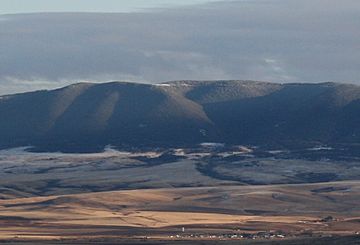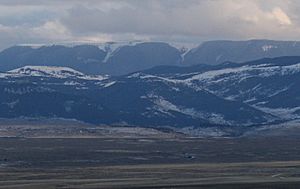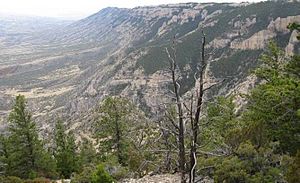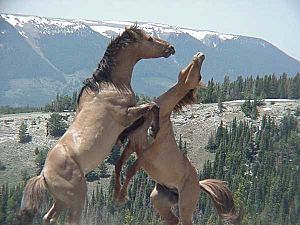Pryor Mountains facts for kids
Quick facts for kids Pryor Mountains |
|
|---|---|

Pryor Mountains
|
|
| Highest point | |
| Peak | East Pryor Mountain |
| Elevation | 8,776 ft (2,675 m) |
| Naming | |
| Native name | Error {{native name}}: an IETF language tag as parameter {{{1}}} is required (help) |
| Geography | |
| Country | United States |
| State | Montana |
The Pryor Mountains are a mountain range in Carbon and Big Horn counties of Montana. They are located on the Crow Indian Reservation and the Custer National Forest, and portions of them are on private land. They lie south of Billings, Montana, and north of Lovell, Wyoming.
The mountains are named for Sergeant Nathaniel Hale Pryor, a member of the Lewis and Clark Expedition who vainly pursued horses stolen from the expedition in the area. The Crow Nation, a Native American tribe which lived nearby, called the mountains Baahpuuo Isawaxaawuua ("Hitting Rock Mountains") because of the abundance of flint there (which was chipped into arrowheads).
According to Crow Nation folklore, Little People (a race of 18-inch (46 cm) high dwarf-like people with spiritual powers) lived in these mountains.
Geology
The Pryor Mountains are a 145,000-square-mile (380,000 km2) region of Montana and Wyoming. The Pryor Mountains consists of Paleozoic, Mesozoic and Cenozoic sedimentary rocks the most prominent unit is limestone (known as the Madison Group limestone) laid down about 300 million years ago. The limestone and older sediments rest on Archean metamorphic rock consisting of gneiss and schists. The gneiss is exposed along the northeast escarpment of East Pryor Mountain. During the Laramide orogeny in the Late Cretaceous and Paleogene Period (about 70 to 60 million years ago), the limestone was faulted and uplifted. The 705 to 740 feet (215 to 226 m) thick limestone blocks were tilted and uplifted as large blocks with the northeastern corner of the blocks forming the Bighorn and the Pryor Mountains.
Caves, carved by groundwater, can be found in the limestone throughout the Pryors. Among the better known are Big Ice Cave on the eastern edge of Pryor Mountain, and Mystery Cave (which contains some of the best speleothems of all the caves in the Pryors). Among the more notable are False Cougar Cave on East Pryor Mountain (which was used by Native Americans at times in the past), Shield Trap Cave (which features a vertical shaft about 33 feet (10 m) deep), Little Ice Cave, and Bell Trap Cave (which is similar to Shield Trap). Other popular features of the Pryors include Froggs Fault, a huge fissure in the earth, and a buffalo jump near Dry Head Lookout. Just below Dry Head Lookout is a small pocket in the cliff face surrounded by a low man-made fence of rock. This is a place used by several Native American tribes for vision quests, and as of 1971 was perhaps the last undisturbed such place in the United States.

The tallest peak in the Pryor Mountains is East Pryor Mountain (elevation 8,822 feet (2,689 m)).
The Bighorn River flows north from Wyoming and through the plateau between the Bighorn and Pryor mountains. The river flows between the two mountain ranges, and has cut the Bighorn Canyon deep into the limestone.
Crooked Creek, one of the few perennial streams in the area, divides the Pryors in two and is one of the few places where Yellowstone cutthroat trout may be found. The Pryors contain the most diverse bat habitat in Montana as well, with 10 species found there.
Wild horse refuge
The Pryor Mountains are also home to the Pryor Mountains Wild Horse Range, a protected area that is home to a herd of free-roaming feral horses. This herd was the subject of the 1995 documentary film Cloud: Wild Stallion of the Rockies and its sequel, the 2003 documentary film Cloud's Legacy: The Wild Stallion Returns.



